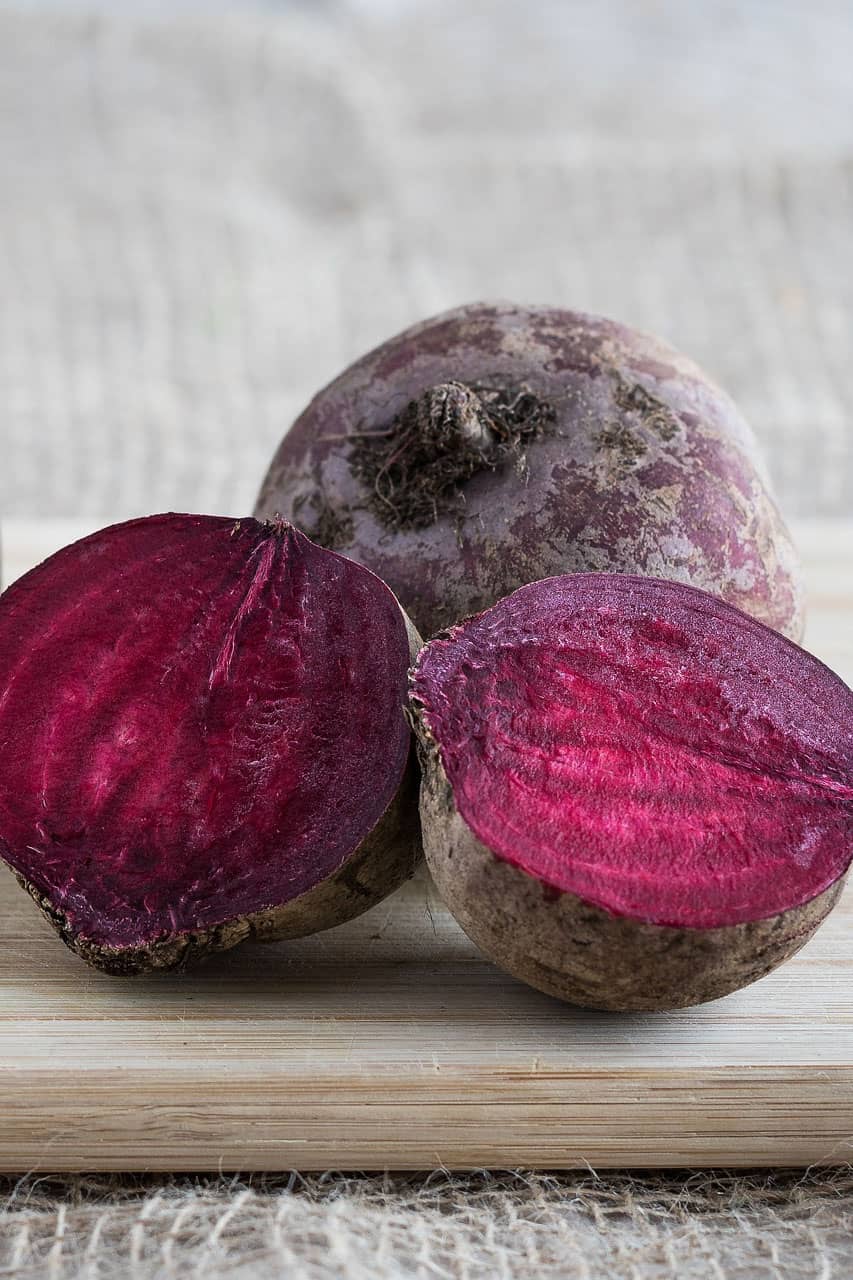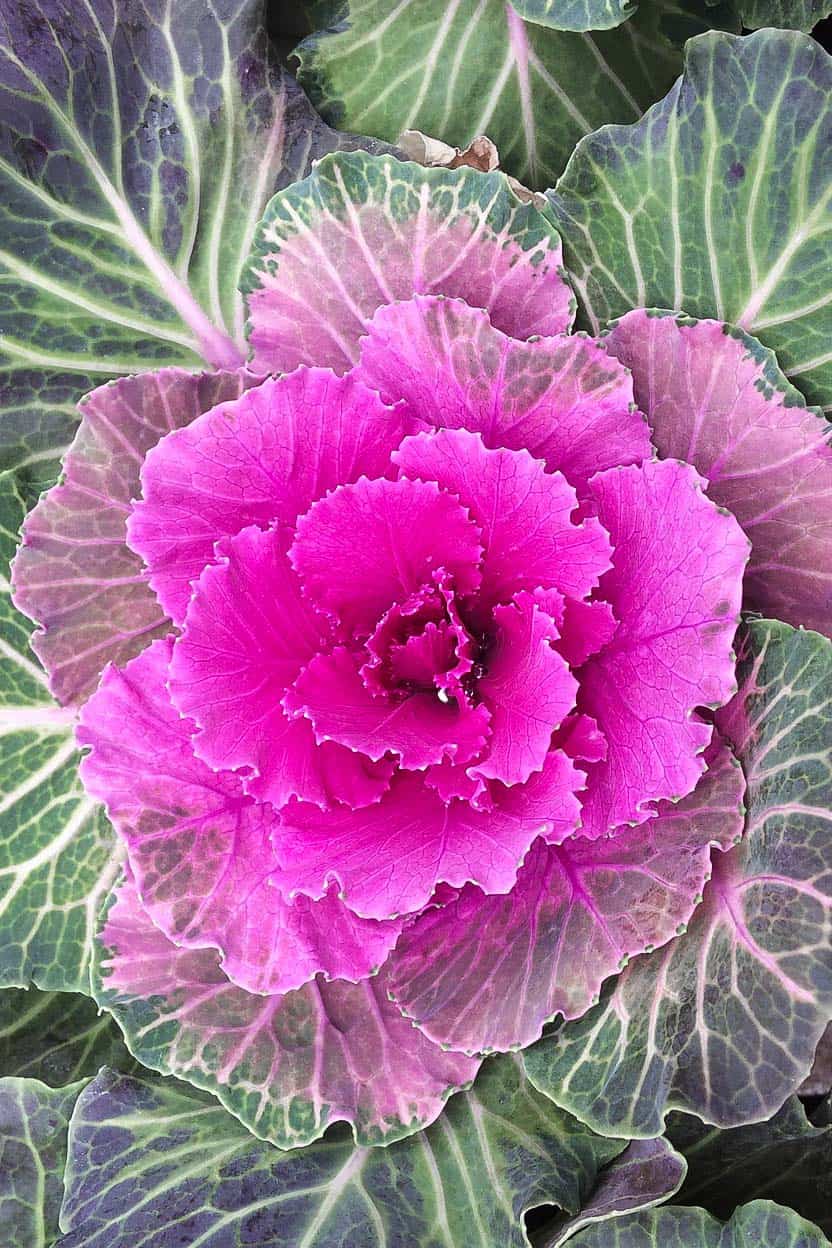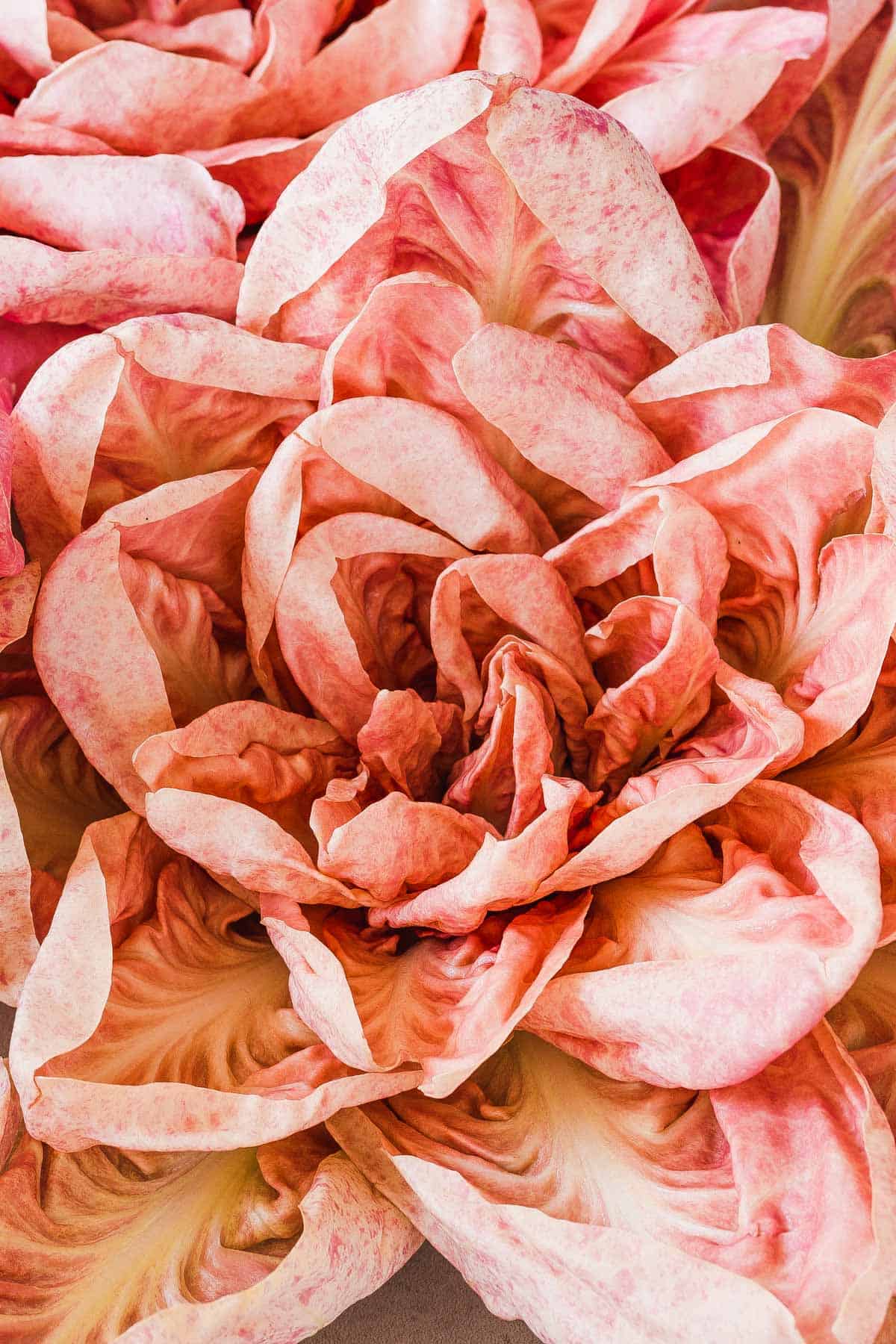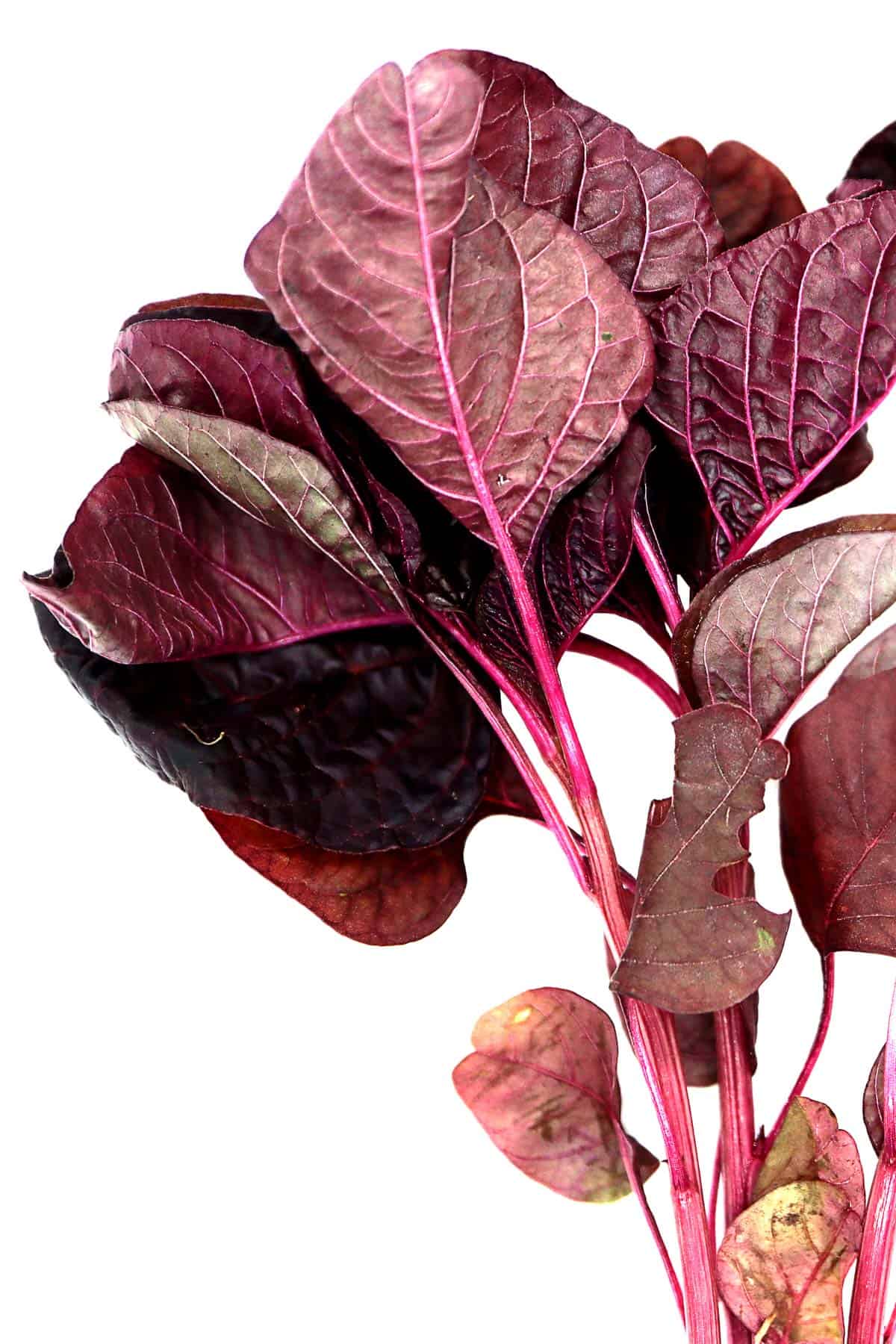The most complete list of pink vegetables you can find on the Internet. From pictures, fun facts, texture, taste, and how to cook them, we’ve got you covered.
Intro and Disclaimer
Get ready for 25 stunning pink vegetables to brighten up your kitchen!✨ From adorable pink radishes to vibrant pink cauliflowers, we’ll explore how they look, fun facts, flavors, and tasty ways to enjoy them.
Quick disclaimer: Some of these vegetables may also look a bit more purple than pink. But you know, light purple with heavy red tones, that’s kinda pink, isn’t it?🤔😀
Alrighty, without further ado………🥁🥁🥁
1. Pink Radish

Fun fact(s): Pink radishes belong to the Brassicaceae family alongside broccoli and cauliflower. Moreover, radishes are rich in calcium, potassium, and other minerals, which help to lower high blood pressure and reduce heart disease risks!💖
Taste and Texture: Whether it’s pink radishes or French breakfast radishes (both pictured above), they both have a crunchy texture and a mildly peppery taste. Note that they might taste a bit bitter if they are not grown in the right conditions.
Uses: Use them in salads, bowls (such as this 30-minute Rainbow Poke Bowl recipe), pickled for added tanginess, or sliced as a colorful garnish.
2. Watermelon Radish🍉

Fun fact(s): Named for their striking pink interior that resembles watermelon flesh, while maintaining a completely white exterior skin (which you can see in my List of 35 White Vegetables).
Taste and Texture: They have a crisp texture and a mild, slightly sweet flavor with a hint of peppery undertones.
Uses: Due to their beauty, I recommend serving watermelon radishes raw such as in salads, or sliced for crudités (raw veggie platter) to really expose the bright and pretty pink interior!
3. Pink Potatoes🥔

Fun fact(s): One of the pink potato varieties (called Kerr’s Pinks potatoes) is the second most popular potato variety in Ireland. This pink root vegetable was first cultivated in Scotland in 1907.
Taste and Texture: Creamy to firm texture similar to regular potatoes, with flavor varying by specific variety.
Uses: Use them in similar ways you would use regular potatoes. Think of boiling, roasting, mashing, or using them in soups and stews for a more hearty meal. They are also great to make French fries, like in my kimchi loaded fries and adobo French fries recipes!
4. Murasaki Sweet Potatoes🍠

Fun fact(s): The Murasaki sweet potatoes have pink to purple outer skin and light yellow flesh inside, which is also why they’re included in my List of 20 Yellow Vegetables💛. Although it is often referred to as Japanese sweet potatoes due to its name, Murasaki sweet potatoes originated in Louisiana in the US.
Taste and Texture: Moist, creamy texture with sweet, slightly nutty flavor.
Uses: Bake, roast, steam, or freeze after baking for a healthy ice cream alternative.
5. Pink Onions🧅

Fun fact(s): Pink onions offer a flavor profile between red and yellow onions: milder than yellow but not as sweet as red varieties.
Taste and Texture: Crisp texture with mild, slightly sweet flavor and reduced sharpness.
Uses: Use pink onions in salads, sandwiches, salsas, and stir-fries, as their vibrant color adds visual appeal to various dishes. They are also great for this 4-ingredient Caramelized Onions and Mushroom recipe!
6. Beet

Fun fact(s): Beets have been used historically as a natural fabric and food dye due to their striking color. Not only that, but beets are also rich in fiber, vitamins, and other minerals.
Taste and Texture: Sweet, earthy flavor with tender texture when cooked and crunchy when raw.
Uses: You can roast, boil, steam, or grate them raw for salads. You can also puree them to use to make pink pancakes, use their juice as a natural dye in baked goods, make a pretty pink beet pasta, or an irresistible beet soup. Their greens are also edible are great for salads as it also adds a pop of pink!
They’re also great substitutes to mimic that ‘beefy’ look. So although they will definitely taste different, check out this 15-Minute Beetroot Tartare, a quick and fancy spin on the classic beef tartare recipe!
7. Chioggia Beet

Fun fact(s): Chioggia beets (or candy cane beets) have a distinctive concentric ring pattern inside. I like to think of them as bull’s eye beets! 🎯
Taste and Texture: Mildly sweet, earthy flavor with tender-crisp raw texture becoming soft and slightly buttery when cooked.
Uses: Serve raw in salads or crudités to preserve striking appearance, or pickle and roast. Similar to other vegetables, I recommend using them raw to preserve their aesthetic appearance. For more creative recipes though, try making a vegan beet carpaccio!
8. Rainbow Swiss Chard

Fun fact(s): Swiss chard is part of the beet family. While beets are mostly grown for their roots, Swiss chards are mostly grown for their stems and leaves.
Taste and Texture: Pink Swiss chard has a slightly bitter and earthy flavor with crunchy stems.
Uses: Cook the leaves by sautéeing, steaming, or using them raw in salads. As for the bright and colorful stems, cook them separately or use them as colorful garnish.
9. Purple Cauliflower

Fun fact(s): The pink/purple color of cauliflower indicates a higher presence of anthocyanins, which are powerful antioxidants known for their potential health benefits. This is the exact same pigment that gives certain flowers and fruits their vibrant hues.
Taste and Texture: Pink cauliflower has a mild, slightly nutty taste and a dense yet tender texture.
Uses: It can be steamed, roasted, stir-fried, or used in recipes where regular cauliflower is called for, bringing a visually appealing twist to the dish!
Maybe some creamy pink cauliflower pasta or roasted pink cauliflower soup, anyone? 😉
10. Pink Kale🥬

Fun fact(s): Ornamental variety grown primarily for aesthetics but completely edible with a similar nutritional profile to regular kale.
Taste and Texture: Similar texture to standard kale varieties but slightly more bitter flavor.
Uses: Add to salads, smoothies, sautés, stir-fries, or bake into crispy kale chips.
11. Ornamental Cabbage

Fun fact(s): Grown primarily for its beautiful, colorful foliage rather than consumption. Easily distinguished from kale by broad, smooth leaves versus curly ‘regular’ kale leaves.
Taste and Texture: While ornamental cabbage is edible, its taste and texture are often less desirable compared to other cabbage varieties. This is because it tends to be more bitter and fibrous.
Uses: People usually use them as a decorative element in flower beds or floral arrangements to add a pop of color to gardens and landscapes.
12. Purple Brussels Sprouts

Fun fact(s): The purple/pink color in Brussels sprouts is due to the presence of anthocyanin. These pigments are also found in other purple-hued vegetables and fruits, contributing to their vibrant colors.
And for more purple vegetables, check out my List of 30 Purple-Colored Vegetables!💜
Taste and Texture: Pink Brussels sprouts have a similar taste and texture to regular green Brussels sprouts, with a slightly more bitter and nuttier flavor and a firm, dense texture.
Uses: They can be roasted, sautéed, steamed, or used in various dishes such as stir-fries, salads, or as a side dish. Being one of my favorite vegetables, it’s definitely something I look forward to in the winter!😋
13. Pink Beans

Fun fact(s): Pink beans, also known as pink kidney beans, are a popular legume variety that is widely used in Latin American, Caribbean, and American cuisines.
Taste and Texture: Mild, slightly sweet flavor with creamy texture when cooked.
Uses: Add to soups, stews, chili, refried beans, salads, and side dishes for plant-based protein.
14. Borlotti Beans

Fun fact(s): This type of bean has many names: sugar beans, red-speckled beans, and cranberry beans. They are named after the distinctive red and beige speckled appearance on their skin.
Cranberry beans are also rich in plant-based protein, fiber, and other vitamins and minerals such as folate, phosphorus, thiamin, and manganese.
Taste and Texture: Mild, slightly nutty flavor with creamy cooked texture.
Uses: Perfect for soups, stews, chili, salads, pasta dishes, and casseroles.
15. Pink Oyster Mushroom🍄

Fun fact(s): Pink oyster mushrooms are a variety of edible oyster mushroom species, known for their delicate pink hue and soft, velvety texture.
Speaking of oyster mushrooms, there is also the regular brown oyster mushrooms, which are a part of my list of 35 Brown Vegetables (+ Photos!) 🤎
Taste and Texture: Pink oyster mushrooms have a mild and delicate flavor with a tender and slightly chewy texture when cooked.
Uses: You can use them the same way you would use regular oyster mushrooms. Think of stir-fries, soups, pasta dishes, or sautés, adding a touch of color and adding that punch of umami to your culinary creations!
16. Pink Chicory (Treviso Pecoce variety)

Fun fact(s): First of all, I have included 3 pink radicchio varieties in this list. The Treviso Precoce variety is a type of chicory that features elongated, pink-tinged leaves with white veins.
Taste and Texture: Slightly bitter, peppery taste with crisp leaf texture.
Uses: Use them in salads, grilled as a side dish, or incorporated into pasta dishes to add a touch of color and flavor.
17. Chioggia Radicchio

Fun fact(s): Also known as red chicory or Italian chicory, has deep red leaves with white veins forming an intricate pattern, which is also why it appeared in my 25 Red Vegetables List❤️
Taste and Texture: It has a bitter and slightly spicy taste, and the leaves are crisp and crunchy.
Uses: Radicchio Chioggia is commonly used in salads, as a grilled vegetable, or added to risotto and pasta dishes for a vibrant and slightly bitter flavor.
18. Pink Radicchio (Rosa del Veneto variety)

Fun fact(s): Rosa del Veneto is a specific variety of radicchio known for its round shape and beautiful and calming pastel pink color.
Taste and Texture: Mild, slightly bitter taste with crisp, crunchy leaves.
Uses: Enjoy them raw in salads so you can preserve their beautiful light pink color, use them as a garnish, or grill them to bring out their unique flavor profile.
19. Rhubarb

Fun fact(s): Although the stalks make for mouthwatering desserts, the leaves are toxic and should not be consumed. However, the stalks are an excellent source of vitamin K, which is important for bone health and blood clotting.
Taste and Texture: Rhubarb stalks have a tart and tangy flavor, with a hard and crisp texture when raw.
Uses: Although commonly used in desserts, such as pies, crisps, and compotes, rhubarb can also be used in savory dishes. Think of chutneys or as a tart ingredient in sauces to add that bit of tanginess, which rounds off any dishes really well!
20. Graffiti Eggplant🍆

Fun fact(s): I’m guessing the name is taken from graffiti art people see in the streets, given their unique and eye-catching purple and white striped skin!
Taste and Texture: Tender, creamy texture with mild, slightly sweet flavor.
Uses: You can grill, roast, sautée, or use them in dishes like ratatouille, stir-fries like in this teriyaki eggplant, roasted like in this harissa aubergine, or salads. Or even better, make a creamy eggplant dip (baba ganoush), which has a similar texture to my 5-Minute Creamy Hummus recipe!
21. Pink Banana Squash🍌🎃

Fun fact(s): The pink banana squash is an heirloom variety of winter squash that is named for its elongated shape, resembling a large banana.
Taste and Texture: Sweet, nutty flavor with dense, creamy texture.
Uses: Use them as a substitute for squash or pumpkin in a recipe, and you’re set to go! So think of pies, casseroles, purees, or simply roasted as a side dish.
22. Mammoth Forage or Purple-Top White Globe Turnip

Fun fact(s): The part of the turnip that grows beneath the ground is white, while the part above the ground is pink/purple!
Taste and Texture: Mildly spicy, peppery flavor when raw, with a crisp and tender flesh.
Uses: Best when cooked by roasting, sautéing, or boiling to mellow spiciness and enhance sweetness.
23. Pink Hopi Corn🌽

Fun fact(s): The pink Hopi corn is an extremely rare Native American corn variety. They are traditionally cultivated by the Hopi (also called the People of Peace) for centuries.
Taste and Texture: As an heirloom variety that is not widely cultivated across the world, there may be variations in flavor and texture. Texture and taste-wise, they would not differ much from the regular yellow corn variety, but it’s best to experience them firsthand for a more accurate description!
Uses: The Hopi would steam their corn overnight and dry it later on to preserve their harvest. Then, they will grind them into cornmeal or add them to stews. I recommend checking out this NMAI Magazine article (the magazine of the Smithsonian’s National Museum) if you’re interested to learn more!
24. Red Spinach

Fun fact(s): Red spinach gets its name from its vibrant red/pink/purple stems and leaves, which make it visually striking and appealing in culinary preparations.
Taste and Texture: Similar to regular spinach with added sweet tones and tender, smooth leaves.
Uses: Use as a substitute for regular spinach in recipes. You can enjoy them raw in salads, added to stir-fries, sautéed as a side dish, or used in soups, stews, and curries.
In Indonesia where I’m originally from, this red spinach variety is widely sold in regular supermarkets. It is often used as a natural food dye too to make stuff like pink noodles. We often cook them into soups (called sayur bening), or stir-fried.
P.S. If you’re a fan of Indonesian cuisine or would like to try one, check out this Vegan Rendang recipe (slowly braised curry-like dish cooked in spices and coconut milk), or this Sticky Tempeh recipe which is a healthy rendition of the Indonesian kering tempeh!
25. Rainbow Carrots🥕

Fun fact(s): Carrots aren’t always orange; they come in multiple colors including purple, yellow, white, red, and pink varieties!
Due to their extensive variety, they also made it to my 33 Black Vegetables List (+ Pictures) and my 20 Yellow Vegetables (Pictures + Names + More)!
Taste and Texture: Sweet, earthy flavor similar to orange carrots with crisp, crunchy texture when fresh.
Uses: Roast, steam, stir-fry, or eat raw in salads and vegetable platters for some aesthetic food content!
Conclusion
So there you have it, folks! A list of pink vegetables that can add a pop of color and nutrition to your meals.
Why stick to boring green salads when you can mix them up with some pink powerhouses✨? So next time you hit the grocery store or farmer’s market, don’t forget to grab some pink produce and get creative in the kitchen. Your taste buds (and Instagram feed) will thank you!😉
And if you like this post, you might also like:
💙 17 Blue Vegetables, ❤️ 25 Red Vegetables, 🧡 30 Orange Vegetables or 30 Orange Fruits, 💛 20 Yellow Vegetables, 🤍 35 White Vegetables, 🩷 37 Pink Fruits, 🖤 33 Black Vegetables, 30 Black Fruits, 🤎 35 Brown Vegetables, or 31 Brown Fruits








Totally fun post! I need to open my eyes a little wider and “think pink” the next time I visit the produce section of my local markets!
Think pink! I love that! Time to go for a little scavenger hunt!🕵️
This was so cool. Did not know about all these vegetables
Love this list! Had so much fun going through it. Thank you!🌸